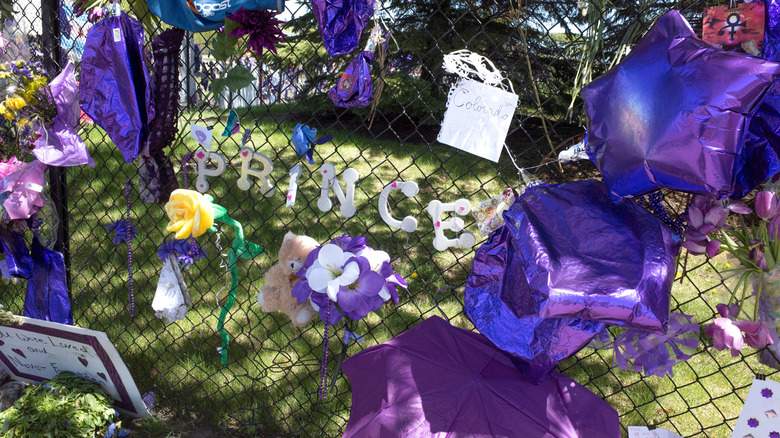What Happened To Prince's Body After He Died?
On April 23, 2016, the crematorium at a funeral home in Minneapolis, Minnesota suddenly roared to life. Soon smoke began rising from the smokestack, as RadarOnline reported from the scene. In this ordinary building — First Memorial Waterston Chapel — one of the least ordinary people in the world was being cremated. The body of singer, songwriter, producer, and guitar impresario Prince turned to smoke and ash just two days after his shocking death at age 57. During a four-hour-long ceremony, Prince's younger sister, Tyka Nelson, and other close family members and friends said their final farewells to the Rock & Roll Hall of Famer and multi-Grammy-winning artist.
Tyka Nelson believed her older brother had known his time was coming to an end. Three years before, Prince had predicted his own death. As reported by People, Tyka told U.K. talk show "Lorraine" that during a phone conversation, he told her, "I think I've done everything I've come to do." Before Prince's remains were cremated, his family had picked up his body from the Midwest Medical Examiner's Office, where the official had just completed Prince's autopsy but hadn't made any determination until the toxicology report was completed. It would be several weeks until the world learned exactly how Prince had died.
He died alone on an elevator at Paisley Park
On the morning of April 21, 2016, Prince collapsed inside an elevator at his sprawling studio and mansion named Paisley Park. He had overdosed from fentanyl-laced pills he believed were the painkiller Vicodin, but turned out to be counterfeit. Among the things we learned about Prince after he died was that he had been suffering from chronic pain related to his wild stage antics that included leaping off risers. "He was in pain all the time, but he was a performer," his one-time girlfriend and fellow singer Sheila E. told Entertainment Tonight not long after Prince's death. He had hip issues including a replacement in 2010, walking pneumonia, and was overusing prescription drugs at the time of his death.
Law enforcement and medics arrived at Paisley Park around 9:45 a.m. that morning and found Prince — dressed head to toe in black — unresponsive. They were unable to revive him and pronounced him dead almost 25 minutes later. On the day Prince died, the media weren't far behind the authorities, quickly descending on his home and studio just outside Minneapolis in the suburb of Chanhassen. Authorities took Prince's body, weighing just 112 pounds, to the Midwest Medical Examiner's Office where the official performed an autopsy. It wasn't until six weeks later that the toxicology report revealed Prince had died of an accidental overdose.
Prince's final resting place
Prince's ashes now reside inside the sprawling estate where he died. In October 2016, Paisley Park opened as a museum dedicated to the intensely private singer. When the exhibition opened, Prince's ashes were on display. The unique urn — designed by his younger sister Tyka and nephew President Nelson — resembles Paisley Park and features his trademark symbol that he once used in place of a name. The 14-inch-tall glass and ceramic urn can be opened to reveal a scale-model of the estate's grand atrium and includes a miniature piano. Prince's ashes are sealed inside the front of the urn.
Prince's ashes were originally on display in the center of the actual grand atrium at Paisley Park, but his family eventually had the urn removed from public view in 2019. The ashes are still inside the estate. "Three years is enough time to mourn," Omarr Baker, Prince's brother, told the Star Tribune at the time. "There's a season for everything." The move angered fans and disappointed Prince's other family members. In 2021, on the fifth anniversary of the singer's death, the museum again publicly displayed the urn. When Prince's ashes will make another public appearance remains to be seen.


